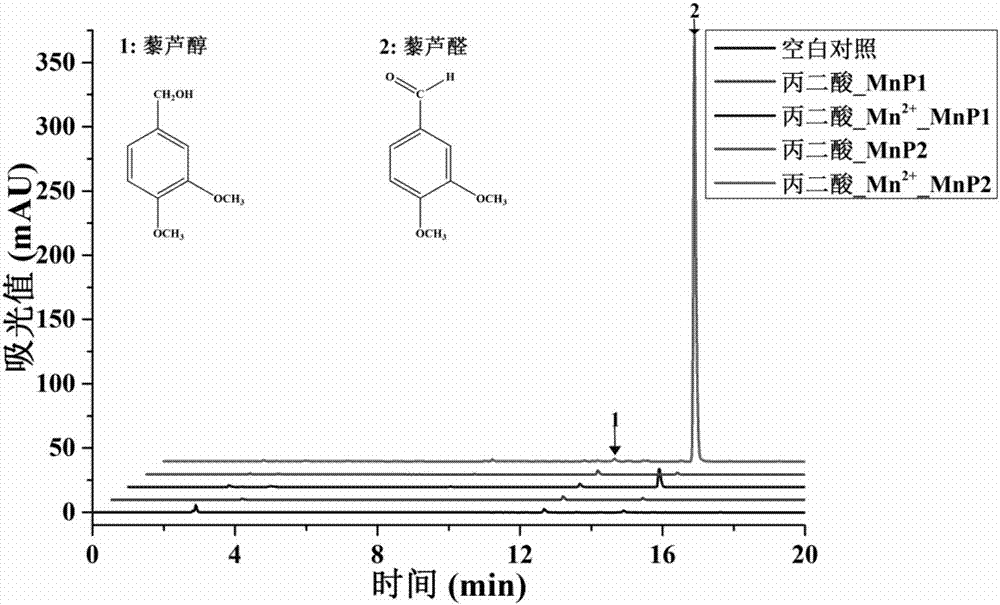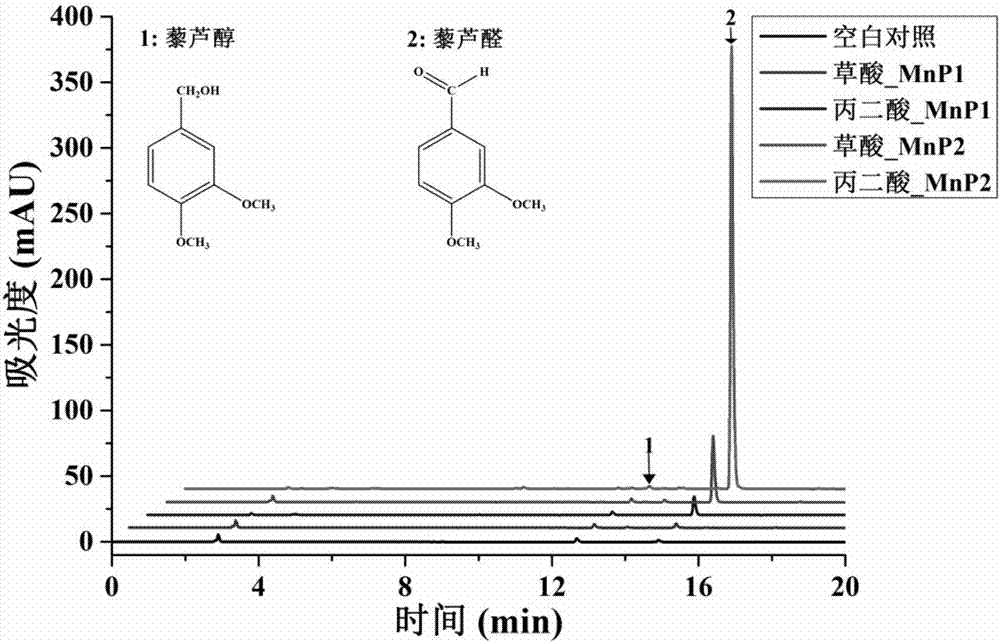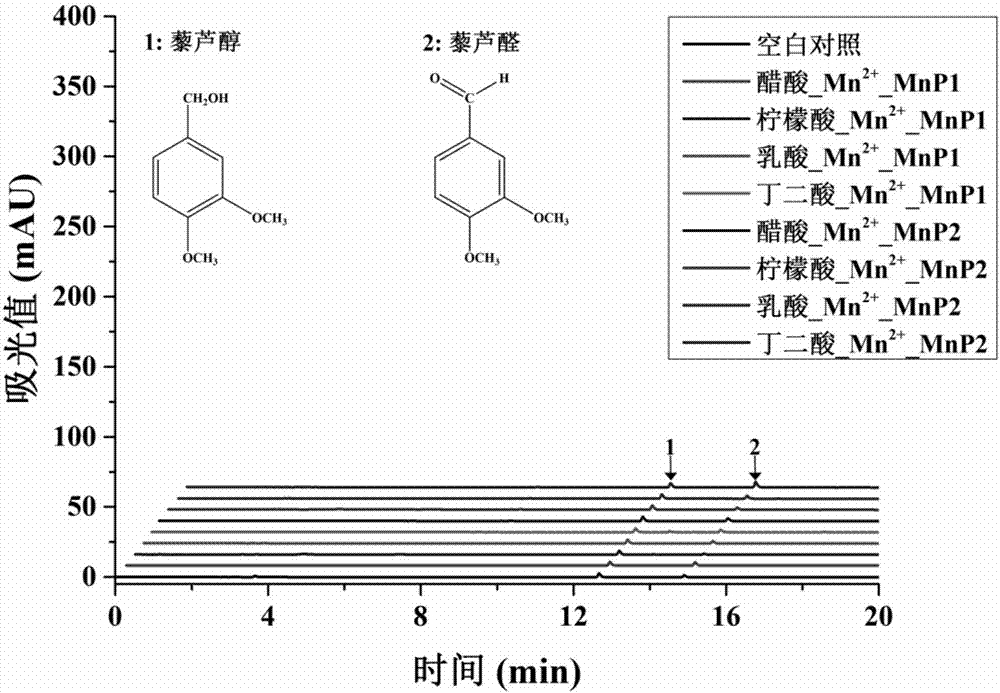Method for degradation of non-phenolic lignin
A lignin, non-phenolic technology, applied in biochemical equipment and methods, enzymes, oxidoreductases, etc., can solve the problem of inability to directly degrade non-phenolic structural units, achieve a wide range of applications, improve degradation efficiency, cost low investment
- Summary
- Abstract
- Description
- Claims
- Application Information
AI Technical Summary
Problems solved by technology
Method used
Image
Examples
Embodiment 1
[0020] The preparation of embodiment 1 recombinant manganese peroxidase
[0021] The amino acid sequence of MnP-1 is as follows:
[0022] MAFKTILAFVALATAALAAPSSRVTCSPGRVVSNGACCKWFDVLDDIQENLFDGGVCGEEVHESLRLTFHDAIGFSLSAEREGKFGGGGADGSIMAFAEIETNFHANNGVDEIVEAQRPFAIKHKVSFGDFIQFAGAVGVSNCLGGPRLEFMAGRSNISRAAPDLTVPEPSDSVDKILARMGDAGFSSSEVVDLLISHTVAAQDHVDPTIPGTPFDSTPSEFDPQFFVETLLKGTLFPGNGSNVGELQSPLRGEFRLQSDALLARDPRTACEWQSFVNNQRLMVTKFEAVMSKLAVLGHNPRDLVDCSEVIPVPPRAKTNVAVLPAGKTRADVQAACAATPFPTLQTAPGPATSIVPV
[0023] The amino acid sequence of MnP-2 is as follows:
[0024] MAFKHLVVALSIVLSLGVAQAAITKRVACPDGKNTATNAACCSLFAIRDDIQANLFDGGECGEEVHESFRLTFHDAIGTGSFGGGGADGSIIVFDDIETNFHANNGVDEIIDEQKPFIARHNITPGDFIQFAGAVGVSNCPGAPRLDFFLGRPNPVAAAPDKTVPEPFDTVDSILARFKDAGGFTPAEIVALLGSHTIAAADHVDPTIPGTPFDSTPEVFDTQVFVEVQLRGTLFPGTGGNQGEVQSPLRGEIRLQSDHDLARDSRTACEWQSFVNNQAKLQSAFKAAFKKLSVLGHNINNLIDCSEVIPEPPNVKVKPATFPAGITHADVEQACATTPFPTLATDPGPATSVAPVPPS
[0025] Get Escherichia coli engineering strains producing mangane...
Embodiment 2
[0026] Example 2 Degradation of non-phenolic lignin by recombinant manganese peroxidase
[0027] The following reaction system: 50 μl malonic acid buffer (0.2M, pH 5.0), 20 μl deionized water, 20 μl non-phenolic lignin veratrol solution, 5 μl manganese sulfate (40 mM), 100 μl manganese peroxidase (1000 U / L), 5 μl hydrogen peroxide (4 mM). The system without adding manganese peroxidase was used as a control, and each manganese peroxidase was replicated three times. The reaction was degraded for 48h at 30°C, and the degradation rate of veratrol was analyzed by high performance liquid chromatography (HPLC). For specific experimental results, see figure 1 .
[0028] Such as figure 1 It was shown that manganese ions are an essential part of the recombinant manganese peroxidase to degrade non-phenolic lignin. In the absence of manganese ions, neither the recombinant peroxidases MnP-1 nor MnP-2 could degrade non-phenolic lignin. prime model compounds.
Embodiment 3
[0029] Example 3 Degradation of non-phenolic lignin by recombinant manganese peroxidase in different organic acid systems
[0030] According to the following reaction system: 50 μl organic acid buffer (0.2M, pH 5.0), 20 μl deionized water, 20 μl veratrol solution, 5 μl manganese sulfate (40 mM), 100 μl manganese peroxidase (1000U / L), 5 μl peroxide Hydrogen (4mM). The organic acid buffers used were malonic acid-sodium malonate, oxalic acid-sodium oxalate, acetic acid-sodium acetate, citric acid-sodium citrate, lactic acid-sodium lactate and succinic acid-sodium succinate. Different organic acid systems of manganese peroxidase were used as controls, and three replicates were set for each manganese peroxidase. The reaction was degraded for 48h at 30°C, and the degradation rate of veratrol was analyzed by high performance liquid chromatography (HPLC). For specific experimental results, see figure 2 .
[0031] Such as figure 2 and image 3 It was shown that different organic...
PUM
 Login to View More
Login to View More Abstract
Description
Claims
Application Information
 Login to View More
Login to View More - R&D
- Intellectual Property
- Life Sciences
- Materials
- Tech Scout
- Unparalleled Data Quality
- Higher Quality Content
- 60% Fewer Hallucinations
Browse by: Latest US Patents, China's latest patents, Technical Efficacy Thesaurus, Application Domain, Technology Topic, Popular Technical Reports.
© 2025 PatSnap. All rights reserved.Legal|Privacy policy|Modern Slavery Act Transparency Statement|Sitemap|About US| Contact US: help@patsnap.com



